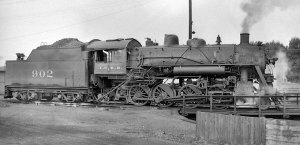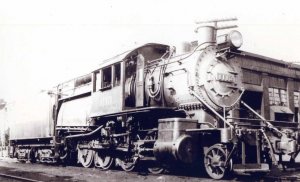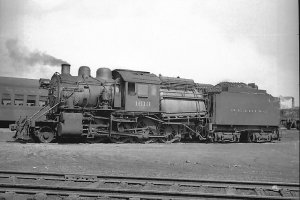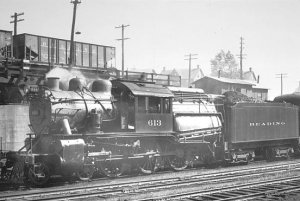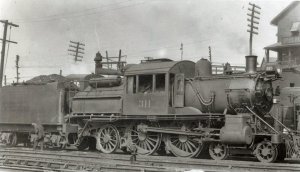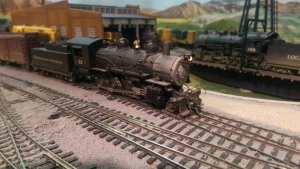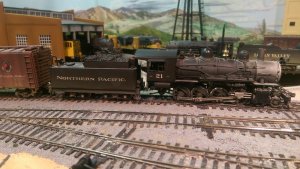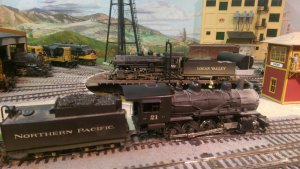You are using an out of date browser. It may not display this or other websites correctly.
You should upgrade or use an alternative browser.
You should upgrade or use an alternative browser.
2-8-0's?
- Thread starter Milwaukee Road 113
- Start date
paper-tiger
Member
@Montanan, the weathered engine and boxcar in your first posted photo are gorgeous! That train looks like it has been running down a gravel road all summer. hehehe
Milwaukee Road 113
Milwaukee Road addict...
Cheers for the link Carey!
Milwaukee Road 113
Milwaukee Road addict...
With all the talk about smaller engines.....had to buy this one, it was a good price!

montanan
Whiskey Merchant
@Montanan, the weathered engine and boxcar in your first posted photo are gorgeous! That train looks like it has been running down a gravel road all summer. hehehe
Thanks for the comment. I was going to post a picture of a Northern Pacific Y-1 consolidation, similar to the one sitting in Butte, MT, but I can't find it. I'll have to do some looking when I have more time. Here's the real one.
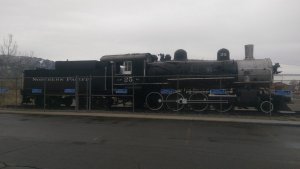
The next one is one we rode on down in Virginia City, NV. I'm sort of partial to consolidations.
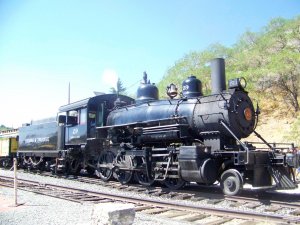
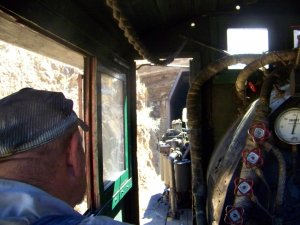
Selector said;
The Spectrum and now standard line 2-8-0 had the "monster" IC consolidation as a prototype. Built by Alco and Baldwin in 1909 and 1911 they were rebuilt by the IC in the 30s. Six of the Baldwins were equipped with 27x30 inch Mikado cylinders, had the drivers reduced to 62 inches by the use of 1/2 inch smaller tires. Boilers were reinforced to accommodate 235 pounds of pressure, BK stokers were added and syphons or circulators placed in the firebox. This gave them a tractive force of 64,460 pounds, more powerful then most Mikados.
Six others had their cylinders bored out to 22 1/2 inches and boilers modified to accommodate 235 pounds of pressure giving them a tractive force of 48,390 pounds, BK stokers were also applied.
Other modifications included a variety of sand domes (the square IC Paducah sand dome was what most people think of but there are photographs of these locomotives in the 1950s with a round sand dome.) moving the air compressors to the front pilot and pressed steel pilots. Number 908 a 1909 Alco build ran in daily service on the Bloomington IL local until January 1958 and wasn't retired until February 1960. It originally weighed 203,500 pounds when it left the Alco factory and weighed 249,000 after the rebuild.
The Bachmann 2-8-0 is a dead on replica of these IC engines before the IC rebuilding program. `
Some of these engines were converted to Mikados by the IC starting in 1916. By 1924 33 were converted to 2-8-2s by increasing the grate area from 51-55 square feet and adding superheaters and power reverse gears. Tractive force was 46,380 pounds at 185 pounds of boiler pressure after the conversion. They were assigned to transfer and local work on the Chicago Terminal Division, New Orleans Terminal Division and the Iowa division.
So yes, the IC had some monster consolidations and that's what Bachmann modeled.
The Decapod and 2-8-0 locos represent small locomotives as were their prototypes. I believe the IC had monster Consolidations, if I recall an old article, but otherwise these were early engines that were brought on line about the same time as the earliest Mikados.
The Spectrum and now standard line 2-8-0 had the "monster" IC consolidation as a prototype. Built by Alco and Baldwin in 1909 and 1911 they were rebuilt by the IC in the 30s. Six of the Baldwins were equipped with 27x30 inch Mikado cylinders, had the drivers reduced to 62 inches by the use of 1/2 inch smaller tires. Boilers were reinforced to accommodate 235 pounds of pressure, BK stokers were added and syphons or circulators placed in the firebox. This gave them a tractive force of 64,460 pounds, more powerful then most Mikados.
Six others had their cylinders bored out to 22 1/2 inches and boilers modified to accommodate 235 pounds of pressure giving them a tractive force of 48,390 pounds, BK stokers were also applied.
Other modifications included a variety of sand domes (the square IC Paducah sand dome was what most people think of but there are photographs of these locomotives in the 1950s with a round sand dome.) moving the air compressors to the front pilot and pressed steel pilots. Number 908 a 1909 Alco build ran in daily service on the Bloomington IL local until January 1958 and wasn't retired until February 1960. It originally weighed 203,500 pounds when it left the Alco factory and weighed 249,000 after the rebuild.
The Bachmann 2-8-0 is a dead on replica of these IC engines before the IC rebuilding program. `
Some of these engines were converted to Mikados by the IC starting in 1916. By 1924 33 were converted to 2-8-2s by increasing the grate area from 51-55 square feet and adding superheaters and power reverse gears. Tractive force was 46,380 pounds at 185 pounds of boiler pressure after the conversion. They were assigned to transfer and local work on the Chicago Terminal Division, New Orleans Terminal Division and the Iowa division.
So yes, the IC had some monster consolidations and that's what Bachmann modeled.
Milwaukee Road 113
Milwaukee Road addict...
Cool....thanks JWhite!
How does these IC machines compare to my favourite 2-8-0's, the Reading I10sa's and Western Maryland's H9's?
How does these IC machines compare to my favourite 2-8-0's, the Reading I10sa's and Western Maryland's H9's?
I model the IC in 1955 so most of my reference material is for the IC. According to the Guide to North American Steam Locomotives the Reading I-10 class had 27x32 foot cylinders, 61 1/2" drivers and weighed 322,690 pounds and developed 71,000 pounds of tractive force. That makes them heavier and more powerful then the IC 900 series consolidations. From the photos I have it looks like the old Bachmann standard 2-8-0 (before the Spectrum was made the current standard line) used this loco as a prototype. The same reference shows the Western Maryland H9 with 27x32" cylinders, 61" drivers, weighing 285,600 pounds and developing 71,500 pounds of tractive force making it the most powerful of the three. There isn't a photo of that one in the book (there is a photo of an H8) so I couldn't guess at what HO locomotive is close to it.
I've got 2 of the old Bachmann models that were prototyped from the Reading engine. One has a broken gear and I have never tried to run the other. They show up on ebay every once in a while.
Jeff
I've got 2 of the old Bachmann models that were prototyped from the Reading engine. One has a broken gear and I have never tried to run the other. They show up on ebay every once in a while.
Jeff
Milwaukee Road 113
Milwaukee Road addict...
Cjcrescent
Master Mechanic
I have one of the older Bachmann 2-8-0's and for some reason, I've always liked the Wooten firebox. I also have a Bowser conversion chassis designed to replace the older Bachmann mechanism. I have the mech assembled and will eventually mate the boiler to it. Just gotta find the time....
Milwaukee Road 113
Milwaukee Road addict...
Milwaukee Road 113
Milwaukee Road addict...
Milwaukee Road 113
Milwaukee Road addict...
Iron Horseman
Well-Known Member
I had to snicker at that one, as I don't think there is any such thing as a nice looking camelback.Reading definitely had some nice looking Camelback 2-8-0's.
The BL-2 is EMD's answer to the Camelback.
Milwaukee Road 113
Milwaukee Road addict...
Have to say that I quite like them now....
Does that mean, that I've go to wear that pointy hat now and sit in the corner, facing inwards?
Does that mean, that I've go to wear that pointy hat now and sit in the corner, facing inwards?

